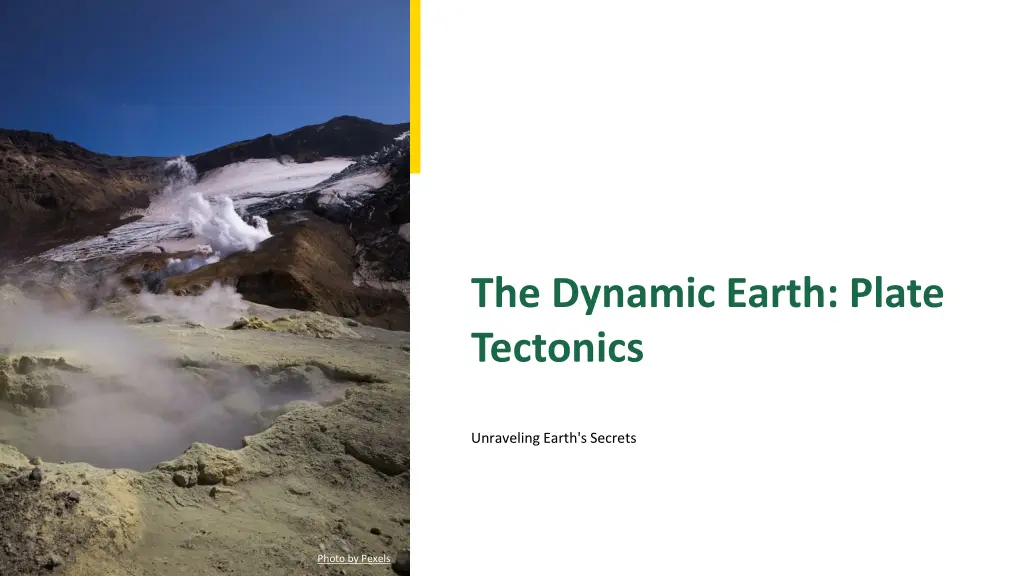
Unraveling Earth's Secrets: Plate Tectonics and Geological Dynamics
Explore the revolutionary theory of plate tectonics to understand Earth's dynamic nature, from the movement of tectonic plates shaping landscapes to historical perspectives like Alfred Wegener's continental drift theory. Dive into the building blocks of Earth's lithosphere and asthenosphere, uncovering how their interactions fuel geological processes like earthquakes and volcanic eruptions. Discover the movement rates of tectonic plates and their effects, leading to remarkable features like mountain ranges and fault lines. Join us in unraveling Earth's secrets through the lens of plate tectonics.
Download Presentation

Please find below an Image/Link to download the presentation.
The content on the website is provided AS IS for your information and personal use only. It may not be sold, licensed, or shared on other websites without obtaining consent from the author. If you encounter any issues during the download, it is possible that the publisher has removed the file from their server.
You are allowed to download the files provided on this website for personal or commercial use, subject to the condition that they are used lawfully. All files are the property of their respective owners.
The content on the website is provided AS IS for your information and personal use only. It may not be sold, licensed, or shared on other websites without obtaining consent from the author.
E N D
Presentation Transcript
The Dynamic Earth: Plate Tectonics Unraveling Earth's Secrets Photo by Pexels
01 Understanding Plate Tectonics Table of Contents 02 The Building Blocks: Lithosphere and Asthenosphere 03 The Movement of Plates 04 Historical Perspective: Alfred Wegener 05 Thank You for Joining!
1 Understanding Plate Tectonics Earth s Moving Puzzle Plate tectonics is a revolutionary theory that explains the movement and interaction of Earth s tectonic plates. This theory describes how these movements shape major landforms like mountains, valleys, and ocean basins. It highlights the dynamic nature of our planet and the forces that mold its surface. This fundamental concept redefined earth sciences by integrating various geological phenomena into one framework. Photo by Pexels
2 The Building Blocks: Lithosphere and Asthenosphere Layers of Earth The lithosphere is the rigid outer layer of Earth, consisting of the crust and upper mantle. Beneath it lies the asthenosphere, a semi-fluid layer that allows tectonic plates to move. Understanding these layers helps us grasp the mechanics behindplate movements and interactions. This interaction fuels geological processes such as earthquakes and volcanic eruptions. Photo by Pexels
3 The Movement of Plates Rates and Effects Tectonic plates move at varying rates, typically between 2 to 15 centimeters annually. These movements result from convection currents within the asthenosphere, driving plate interactions. The results of these movements can be dramatic, leading to mountain ranges, rifts, and fault lines. For instance, the Himalayas and the San Andreas Fault are famous results of this dynamic process. Photo by Pexels
4 Historical Perspective: Alfred Wegener The Pioneering Mind Alfred Wegener proposed the concept of continental drift, suggesting that continents were once joined together. His theories laid the groundwork for the development of the plate tectonics theory in the 1960s. Though initially controversial, his ideas eventually transformed our understanding of Earth's geological history. Wegener s vision of moving continents continues to inspire geologists today. Photo by Pexels
5 Thank You for Joining! Explore More Thank you for your attention! We hope this presentation has sparked your interest in plate tectonics. Understanding these dynamics is essential for grasping how our planet works. Let s continue learningabout Earth s wonders together! Photo by Pexels
